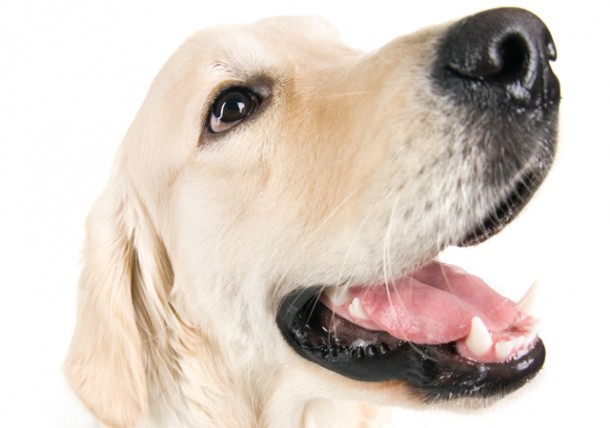Tartar and Tooth Loss in Pets

Who has never commented on their pet’s breath? Dental prophylaxiscleaning procedure performed to thoroughly clean the teeth or a dental cleaning is one of the most common procedures requiring anesthesia in veterinary clinics. Dental disease can cause many problems, such as bad breath, difficulty chewing and chronic gum infections, which may cause inflammation of other organs. If left untreated, periodontal diseaseinfections of the structures around the teeth will lead to tooth loss, tooth abscess and possible tooth extraction, all of which are painful for the pet.
Periodontal disease
Periodontal disease is secondary to the build-up of plaque and tartar. Tartar, or calculus, is mineralized plaque on the teeth. Daily brushing can help remove plaque before it becomes mineralized. The plaque left on teeth will become colonized by bacteria in the mouth and over time will continue to multiply and become part of the tartar attached to the tooth. As the tartar builds, the bacteria become part of a biofilm that worsens and goes up under the gum line. This infection will cause breakdown of the bony socket that holds the tooth, and the tooth will slowly loosen its attachment to the bone. This loss of the periodontal ligament is known as a “pocket.” As the pocket worsens from the subgingival (under the gum) infection, it will cause the tooth to loosen and may even reach the root area and cause a root abscess.
Patients with bad dental disease will have halitosis or bad breath from the periodontal disease and high bacterial population in the mouth. Severe halitosis is a sign of dental and oral disease. When your veterinarian performs the dental cleaning, he or she will mechanically clean above and below the gumline to remove all plaque and tartar and assess the periodontal disease. Antibiotics may be prescribed if the veterinarian believes they are necessary.
Dental Hygiene Regimen
After the teeth are cleaned, your veterinarian will prescribe a home maintenance program, including brushing with toothpaste made for your pet to prevent further plaque buildup and subsequent disease. You can use a soft bristle brush on the outside of teeth along the gum line. It also helps to chew rawhide and other dental treats. There are also dog foods that are made to help prevent tartar buildup. Ask your veterinarian for recommendations.
Cat Cavities?
Dogs don’t usually get cavities like humans do, but cats can experience a cavity-like tooth problem called tooth resorption. These lesions cause the mineralized components of the tooth to break down. The enamelhard mineralized surface of teeth will eventually be lost, exposing the sensitive dentine below. These lesions are painful and may cause the crown of the tooth to fracture off. These teeth must be extracted completely to remove the pain; there is no repair possible with these lesions.
Fractured Teeth
Pets also commonly fracture their teeth by chewing hard objects or by experiencing trauma from other injuries, such as fighting or being hit by a car. If the pulp canal is exposed when the tooth fractures (visible as a blood spot in the center), it will be painful and require immediate attention. The only treatment options for a broken tooth are extraction or endodontic therapysequence of treatment for the infected pulp of a tooth which results in the elimination of infection and the protection of the decontaminated tooth from future microbial invasion such as root canal therapy. If the tooth is treated within 24 to 48 hours, it may be possible to cap the tooth and save it. If left untreated, a fractured tooth will eventually lead to a root abscess.
Cats tend to fracture their upper canine teeth by bumping them on something hard. Dogs commonly fracture their canine teeth as well. They also frequently get fractures of their upper fourth premolars and first molars from gnawing on a hard bone or chewing rocks or something else too firm to soften. A dog with swelling of the face just below the eye may have may have a root abscess of the fourth premolar or first molar (these are the large scissor-like crushing teeth on the side of the cheek.) These are painful and require extraction or root canal therapy.
Annual Dental Exams
Yearly dental cleanings in which the teeth are scaled and polished will slow the progression of gum disease. By removing the tartar, you can have a fresh start and then brush or take other steps to prevent further tartar buildup. If you start a home maintenance program of brushing or special dental dog chews, you may not need teeth cleanings in the future, so that can certainly help with motivation!
You should encourage your dog to chew to help keep the teeth clean but should not allow your dog to chew anything hard enough to fracture teeth. The rule of thumb is if you hit your kneecap with the dog’s toy and it hurts, then you need something softer!
John Unflat, DVM is a graduate of Kansas State College of Veterinary Medicine and lives in Austin, Texas. Dr. Unflat does relief veterinary work in Austin, and also regularly practices at Barton Creek Animal Clinic and Companion Animal Hospital.

